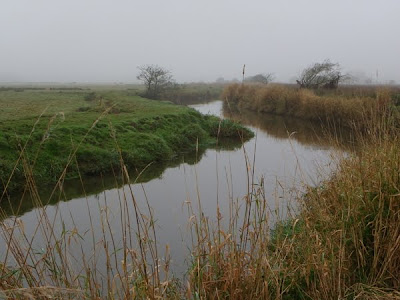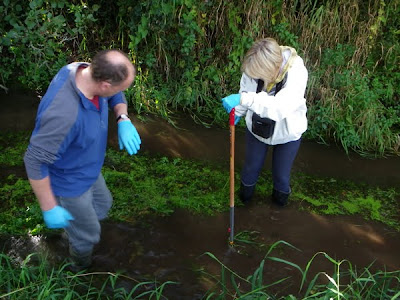 This famous Well is a little walk up from the lake.
This famous Well is a little walk up from the lake.
This blog is a recording of field trips during my undergraduate degree at LIT Thurles,Ireland.
Tuesday, November 30, 2010
White-throated Dipper
 This amazing bird lives along fast flowing water where it dives for aquatic invertebrates. It has also been known to walk along the bottom of a river or stream.
This amazing bird lives along fast flowing water where it dives for aquatic invertebrates. It has also been known to walk along the bottom of a river or stream.
Labels:
bird,
Dipper,
ireland,
owenduff,
stones,
water,
water bird,
wexford,
White-troated Dipper
Marlfield Lake
Tufted Duck
 Male and female Tufted Duck a migratory species from the north. Both have a striking yellow coloured eyes.
Male and female Tufted Duck a migratory species from the north. Both have a striking yellow coloured eyes.
Swan flight
Marlfield lake grid reference S172221 at Clonmell Co Tipperary was our next fieldtrip on the 10/Nov/2010. The lake is a shallow manmade one built in 1880 when the Marlfield river was dammed to produce hydro power for a flour mill. The lake is nationally important for Shovler Duck but Gadwall, Mallard,Teal and Wigeon also can be found here along with various other waiding birds. Due to these bird species and spectacular natural beauty of the lake the area has become a valued recreational facility for the surrounding area of Clonmell town. The social attachment this brings to an area can help highlight important environmental issues as they arise, such as a disease called pink Flamingo which occurs in Swan species that feed on bread given to them by the public. This disease was noticed by Tipperary Institute students last year. Swans have an inability to digest bread therefore a bacteria causes their feathers to turn a pink colour.
There was a very tranquil feel to the lake on our arrival, as fog and mist blanketed the water before the energy of the sun quickly imposed it's power.
There was a very tranquil feel to the lake on our arrival, as fog and mist blanketed the water before the energy of the sun quickly imposed it's power.
Saturday, November 27, 2010
Thursday, November 25, 2010
Fallow Deer
 A population of 40 Fallow Deer roam the area. Thick fog sometimes creates interesting results as it can aid to blur an image.
A population of 40 Fallow Deer roam the area. Thick fog sometimes creates interesting results as it can aid to blur an image.
On the 12/Oct/2010 we visited the Little Brosna Callows located in Co Offaly (grid ref: M907115). The Callows is a very important inland area for many globally threatened bird species. The site is SPA designated from the EU habitats directive because of this. The area is a natural flood plane of the Brosna river that floods its banks between Oct- Apr every year. The site has two bird hides one being the oldest in Ireland and in need of repair. The site is counted every year at different times and all data is sent to the Irish Wetland Bird Suryey (I-WeBS). The area is internationally important for Greenland White-fronted Geese, Golden Plover and Black-tailed Godwit.
Monday, November 8, 2010
Leech stretching
 The leech can stretch out over twice their normal body size. The head is the narrow end where clusters of eyespots between 1-10 can be found
The leech can stretch out over twice their normal body size. The head is the narrow end where clusters of eyespots between 1-10 can be found
Freshwater Shrimp
Cabragh wetlands outside Thurles (Grid Reference: S108552) was our next fieldtrip stop on the 6/Oct/2010. Here we started the day by taking measurements along the Cabragh river such as water flow rate, slope and aspect. We conducted a biotic index to discover what invertebrates were present. This helped gauge pollution levels and overall health of this stretch of river. We also spent some time doing Bird identification in a Bird hide.
Metal Trees
 Unobtrusive infrastructure can help change the minds of peoples perception to our environment. This metal structure is used for communications.
Unobtrusive infrastructure can help change the minds of peoples perception to our environment. This metal structure is used for communications.
Labels:
blue sky,
communications,
environment,
metal trees,
Perception,
trees
Saturday, November 6, 2010
The world famous Corrie lake
 Corries or Cirque are usually found surrounded by three sides of steep cliffs. This back cliff here in sunlight is nearly 300 meters tall. Artic Char were once found in this crystal clear water but haven't being recorded since 1930. Common Heather is shown in the foreground an important plant species for the Red Grouse. Bird watch Ireland conducted a two year survay between 2006-2008 and found that its historic breeding range has being reduced by 50%.
Corries or Cirque are usually found surrounded by three sides of steep cliffs. This back cliff here in sunlight is nearly 300 meters tall. Artic Char were once found in this crystal clear water but haven't being recorded since 1930. Common Heather is shown in the foreground an important plant species for the Red Grouse. Bird watch Ireland conducted a two year survay between 2006-2008 and found that its historic breeding range has being reduced by 50%.
Nunatak
 Nunatak is the name given to the exposed peak of a mountain. If the glacier had retreated over this peak it would be more rounded and smooth. Years of erosion has given it its jagged shape.
Nunatak is the name given to the exposed peak of a mountain. If the glacier had retreated over this peak it would be more rounded and smooth. Years of erosion has given it its jagged shape.
Counshingaun

This was our first fieldtrip on the 29/Sep/2010 a glourious day in the Comeragh Mountains Co Waterford 52 15 North/ 7 31 West. During the last ice age a glacier would have formed in the area. As the climate slowly became milder the glacier retreated down the mountain where it left behind an area knows as a moraine. Debris including huge rocks are strewn all along this side of the mountain. Today its a very important habitat for many of Irelands and globally threatened species such as shining sicklemoss (Drepanocladus vernicosus) Peregrine Falcon and Hen Harrier.
Welcome everybody.
This blog site is linked to my Honors Degree in Environmental & Natural Resource Management in Tipperary Institute Ireland. I'm currently in my second year of study where the exciting module of Field-studies Skills is already underway. With the guidance from module leader Mike Maunsell it promises to be an intresting year in the field with activities that include species identification, sampling techniques and GIS mapping.
This blog site is linked to my Honors Degree in Environmental & Natural Resource Management in Tipperary Institute Ireland. I'm currently in my second year of study where the exciting module of Field-studies Skills is already underway. With the guidance from module leader Mike Maunsell it promises to be an intresting year in the field with activities that include species identification, sampling techniques and GIS mapping.
Subscribe to:
Comments (Atom)




















